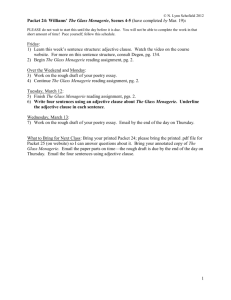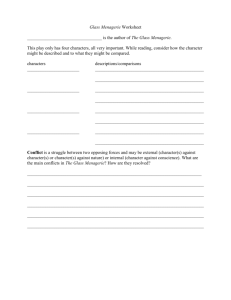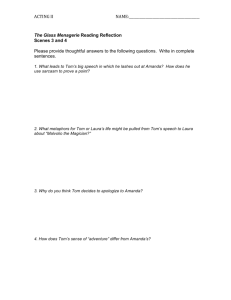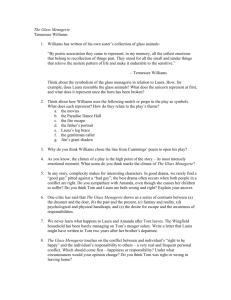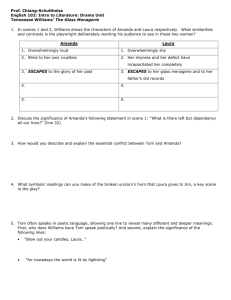Glass Menagerie
advertisement
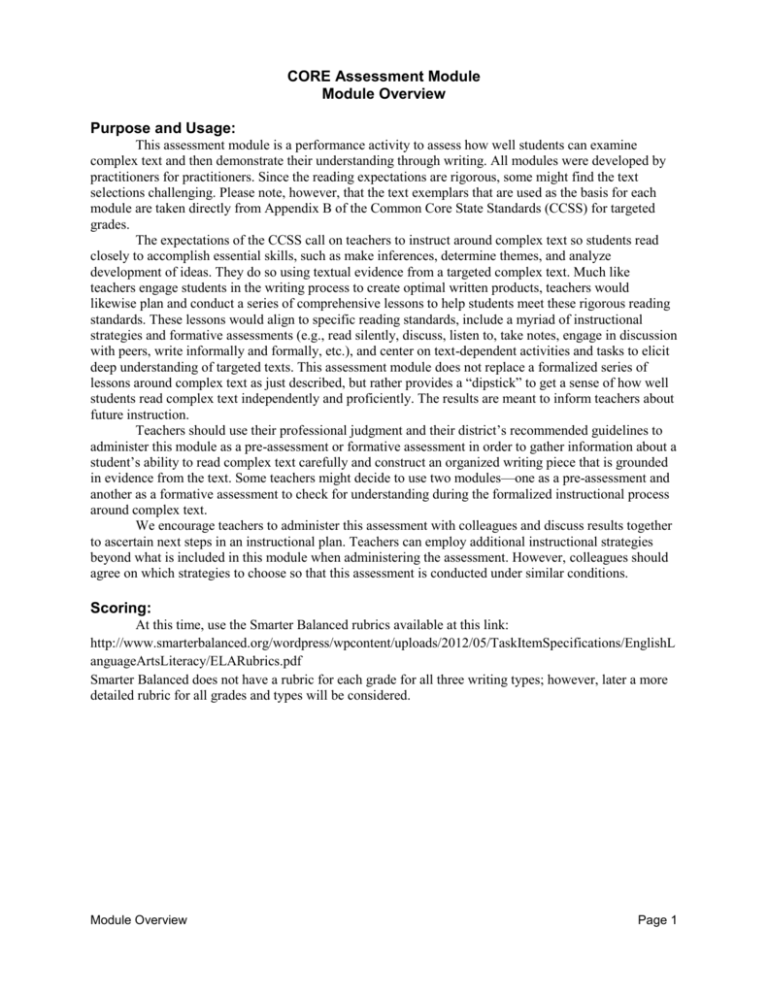
CORE Assessment Module Module Overview Purpose and Usage: This assessment module is a performance activity to assess how well students can examine complex text and then demonstrate their understanding through writing. All modules were developed by practitioners for practitioners. Since the reading expectations are rigorous, some might find the text selections challenging. Please note, however, that the text exemplars that are used as the basis for each module are taken directly from Appendix B of the Common Core State Standards (CCSS) for targeted grades. The expectations of the CCSS call on teachers to instruct around complex text so students read closely to accomplish essential skills, such as make inferences, determine themes, and analyze development of ideas. They do so using textual evidence from a targeted complex text. Much like teachers engage students in the writing process to create optimal written products, teachers would likewise plan and conduct a series of comprehensive lessons to help students meet these rigorous reading standards. These lessons would align to specific reading standards, include a myriad of instructional strategies and formative assessments (e.g., read silently, discuss, listen to, take notes, engage in discussion with peers, write informally and formally, etc.), and center on text-dependent activities and tasks to elicit deep understanding of targeted texts. This assessment module does not replace a formalized series of lessons around complex text as just described, but rather provides a “dipstick” to get a sense of how well students read complex text independently and proficiently. The results are meant to inform teachers about future instruction. Teachers should use their professional judgment and their district’s recommended guidelines to administer this module as a pre-assessment or formative assessment in order to gather information about a student’s ability to read complex text carefully and construct an organized writing piece that is grounded in evidence from the text. Some teachers might decide to use two modules—one as a pre-assessment and another as a formative assessment to check for understanding during the formalized instructional process around complex text. We encourage teachers to administer this assessment with colleagues and discuss results together to ascertain next steps in an instructional plan. Teachers can employ additional instructional strategies beyond what is included in this module when administering the assessment. However, colleagues should agree on which strategies to choose so that this assessment is conducted under similar conditions. Scoring: At this time, use the Smarter Balanced rubrics available at this link: http://www.smarterbalanced.org/wordpress/wpcontent/uploads/2012/05/TaskItemSpecifications/EnglishL anguageArtsLiteracy/ELARubrics.pdf Smarter Balanced does not have a rubric for each grade for all three writing types; however, later a more detailed rubric for all grades and types will be considered. Module Overview Page 1 Content Area Text Grade Level Target Area Common Core State Standards Smarter Balanced Assessment Claims Task Overview Module Components English Language Arts The Glass Menagerie, by Tennessee Williams Grade 9 Informative/Explanatory Writing, Performance Task RL 9-10.1 Cite strong and thorough textual evidence to support analysis of what the text says explicitly as well as inferences drawn from the text. RL 9-10.2 Determine a theme or central idea of a text and analyze in detail its development over the course of the text, including how it emerges and is shaped and refined by specific details; provide an objective summary of the text. RL 9-10.3 Analyze how complex characters (e.g., those with multiple or conflicting motivations) develop over the course of a text, interact with other characters, and advance the plot or develop the theme. RL 9-10.4 Determine the meaning of words and phrases as they are used in the text, including figurative and connotative meanings; analyze the cumulative impact of specific word choices on meaning and tone (e.g., how the language evokes a sense of time and place; how it sets a formal or informal tone). W 9-10.2 Write informative/explanatory texts to examine and convey complex ideas, concepts, and information clearly and accurately through the effective selection, organization, and analysis of content. *SL 9-10.1 Initiate and participate effectively in a range of collaborative discussions (one-on-one, in groups, and teacher-led) with diverse partners on grades 9–10 topics, texts, and issues, building on others’ ideas and expressing their won clearly and persuasively. Claim 1: Students can read closely and analytically to comprehend a range of increasingly complex literary and informational texts. Claim 2: Students can produce effective and well-grounded writing for a range of purposes and audiences. This assessment task can be completed in two class periods after completing a drama unit. The students will have a chance to silently read a scene from The Glass Menagerie, and then perform the scene out loud with a partner. Based on their readings and oral interpretations, students will write an explanatory essay that demonstrates their understanding of the complex ideas, concepts, and information presented in the scene and provide an analysis of its content. 1) Directions to Teacher 2) Text Passage 3) Text-Dependent Questions Graphic Organizer 4) Constructed-Response Questions 5) Writing Task *Standard addressed but not explicitly assessed. Module Overview Grade 9 ELA: The Glass Menagerie Page 2 The Glass Menagerie Directions to Teacher This Common Core-aligned ELA Performance Task can be given over two days depending on class schedules. The directions below outline the steps to follow for a two-day administration. Teacher Preparation: The assessment should be given after the completion of a drama unit, so that the students are aware of the format and structure of a dramatic scene from a play. Text: Williams, Tennessee. The Glass Menagerie. New York: New Directions, 1966. (1944) Materials: The Glass Menagerie Text Passage Text-Dependent Questions Graphic Organizer Constructed-Response Questions Writing Task Lined paper for writing Day 1 1. Reading: RL 9-10.1, *SL 9-10.1 (Approximately 10 minutes) Give students a copy of the scene from The Glass Menagerie and instruct them to read it silently. Then read the scene out loud to the students, just so they can hear the language. Discuss as a class the time period of the scene. Ask students to briefly discuss with a partner the physical positioning of the characters. Invite the students to explain reasons for their interpretations. (At this point, do not discuss the characters of Tom and Amanda. Students will have a chance to understand these characters after the initial discussion.) 2. Note-taking: RL 9-10.1, RL 9-10.3 (Approximately 15 minutes) Hand out the Graphic Organizer, and ask students to reread the passage and complete the “My Response” and “Evidence From the Text” sections as directed in the graphic organizer. Encourage students to expand their thinking beyond the literal answer to the question. 3. Speaking/Listening Questions: *SL 9-10.1 (Approximately 20 minutes) Invite the students to reread the scene. Ask them to underline/highlight words or phrases that they feel should be stressed (voice inflection), to annotate the text for where they feel certain emotion is building, and maybe even to mark where certain body/facial gestures might be made. Once the students complete their review, have them “pair up.” Explain to the students that they are to “perform” the scene: one student reading Amanda’s part, and the other student reading Tom’s part. Remind students of prior drama discussions about voice inflection and word interpretation. Explain that as they immerse themselves in their roles, they will be better able to understand the motivations and actions of the characters. When you give the command “action,” the students should begin reading their scene out loud. When the scenes are completed, ask the students to switch roles and read for the other character. When the students have completed reading for both roles, invite the students to return to their individual seats. Grade 9 ELA: The Glass Menagerie Page 3 Day 2 4. Speaking/Listening Questions: RL 9-10.1, RL 9-10.3, *SL 9-10.1 (Approximately 15 minutes) Instruct students to reread the scene and review the graphic organizer they worked on the previous day. Instruct them to discuss with their partners what they recorded in the first two columns. After their discussion, they are to add their new ideas or their validated thoughts to the last column of the organizer “My Thoughts Now.” 5. Constructed-Response Items: RL 9-10.1, RL 9-10.2, RL 9-10.3, RL 9-10.4 (Approximately 25 minutes) Hand out the Constructed-Response Questions and ask students to individually write their responses to the questions on a separate piece of lined paper. Explain that their constructed responses will be used to help them with the writing prompt. a. Word Meanings 1. Based on the context in the scene, what does the word “supercilious” mean? 2. Why does Williams use the word “interrogation” in the scene’s stage directions? b. Key Details 1. Which words and phrases in the scene’s dialogue help the reader understand the conflict between Amanda and Tom? Cite two phrases. c. Central Ideas 2. What are Amanda’s views about social status? 3. How does the explicit and implied information about Amanda’s background help the reader understand her current attitudes? Day 2 6. Performance Task (Writing Prompt) (Approximately 50 minutes) Provide students with the writing prompt. Let them know the amount of time they have to respond to the prompt in writing. Encourage students to use their graphic organizer and/or constructed-response questions to inform their writing. Grade 9 ELA: The Glass Menagerie Page 4 Student Name ______________________ The Glass Menagerie Text Passage TOM: What are you doing? AMANDA: I’m brushing that cowlick down! [She attacks his hair with the brush.] What is this young man’s position at the warehouse? TOM [submitting grimly to the brush and interrogation]: This young man’s position is that of a shipping clerk, Mother. AMANDA: Sounds to me like a fairly responsible job, the sort of a job you would be in if you had more get-up. What is his salary? Have you any idea? TOM: I would judge it to be approximately eighty-five dollars a month. AMANDA: Well—not princely—but— TOM: Twenty more than I make. AMANDA: Yes, how well I know! But for a family man, eighty-five dollars a month is not much more than you can just get by on . . . TOM: Yes, but Mr. O’Connor is not a family man. AMANDA: He might be, mightn’t he? Some time in the future? TOM: I see. Plans and provisions. AMANDA: You are the only young man that I know of who ignores the fact that the future becomes the present, the present the past, and the past turns into everlasting regret if you don’t plan for it! TOM: I will think that over and see what I can make of it. AMANDA: Don’t be supercilious with your mother! Tell me some more about this—what do you call him? TOM: James D. O’Connor. The D. is for Delaney. AMANDA: Irish on both sides! Gracious! And doesn’t drink? TOM: Shall I call him up and ask him right this minute? ELA Grade 9: The Glass Menagerie Page 5 Student Name ______________________ AMANDA: The only way to find out about those things is to make discreet inquiries at the proper moment. When I was a girl in Blue Mountain and it was suspected that a young man drank, the girl whose attentions he had been receiving, if any girl was, would sometimes speak to the minister of his church, or rather her father would if her father was living, and sort of feel him out on the young man’s character. That is the way such things are discreetly handled to keep a young woman from making a tragic mistake! TOM: Then how did you happen to make a tragic mistake? AMANDA: That innocent look of your father’s had everyone fooled! He smiled—the world was enchanted! No girl can do worse than put herself at the mercy of a handsome appearance! I hope that Mr. O’Connor is not too good-looking. Williams, Tennessee. The Glass Menagerie. New York: New Directions, 1966. (1944). From Scene 5. ELA Grade 9: The Glass Menagerie Page 6 Student Name ______________________ Text-Dependent Questions Graphic Organizer Directions: After rereading the text, write answers to each question below in the “My Response” section. Support each response by recording textual evidence in the “Evidence From the Text” section. After you are given time to talk to a classmate and share ideas, complete the “My Thoughts Now” section based on your conversation. 1. Based on the scene, what is Amanda’s attitude toward Tom? My Response Evidence From the Text My Thoughts Now 2. Based on the scene, what is Tom’s attitude toward Amanda? My Response Evidence From the Text My Thoughts Now ELA Grade 9: The Glass Menagerie Page 7 Student Name ______________________ 3. What is the mood in the scene? My Response Evidence From the Text My Thoughts Now ELA Grade 9: The Glass Menagerie Page 8 Student Name ______________________ The Glass Menagerie Constructed-Response Questions Directions: Answer the questions below on a separate sheet of lined paper. You may use this sheet to make any notes or draft your response, but only your complete answers on a separate sheet of paper will be scored. You may refer to the reading passage and your graphic organizer to help you answer the questions. Word Meanings 1. Based on the context in the scene, what does the word “supercilious” mean? 2. Why does Williams use the word “interrogation” in the scene’s stage directions? Key Details 1. Which words and phrases in the scene’s dialogue help the reader understand the conflict between Amanda and Tom? Cite two phrases. Central Ideas 1. What are Amanda’s views about social status? 2. How does the explicit and implied information about Amanda’s background help the reader understand her current attitudes? ELA Grade 9: The Glass Menagerie Page 9 Student Name ______________________ The Glass Menagerie Writing Task Directions: Please respond to the prompt below in writing. You may use your graphic organizer and/or Constructed-Response Questions to inform your writing. You may take notes on this paper, but you should write your entire response on the lined paper provided by your teacher. Writing Prompt Read the lines from The Glass Menagerie. AMANDA: You are the only young man that I know of who ignores the fact that the future becomes the present, the present the past, and the past turns into everlasting regret if you don’t plan for it! Based on the scene from The Glass Menagerie, analyze the significance of the lines. Explain how the lines relate to the other characters as well as how they relate to Amanda’s life. Cite specific evidence from the play to support your analysis. Be Sure To: Include relevant facts, definitions, concrete details, quotations, or other information Use appropriate transitions Use precise language and vocabulary to inform or explain your topic Establish and maintain a formal style Provide a concluding section that follows from and supports your explanation ELA Grade 9: The Glass Menagerie Page 10

